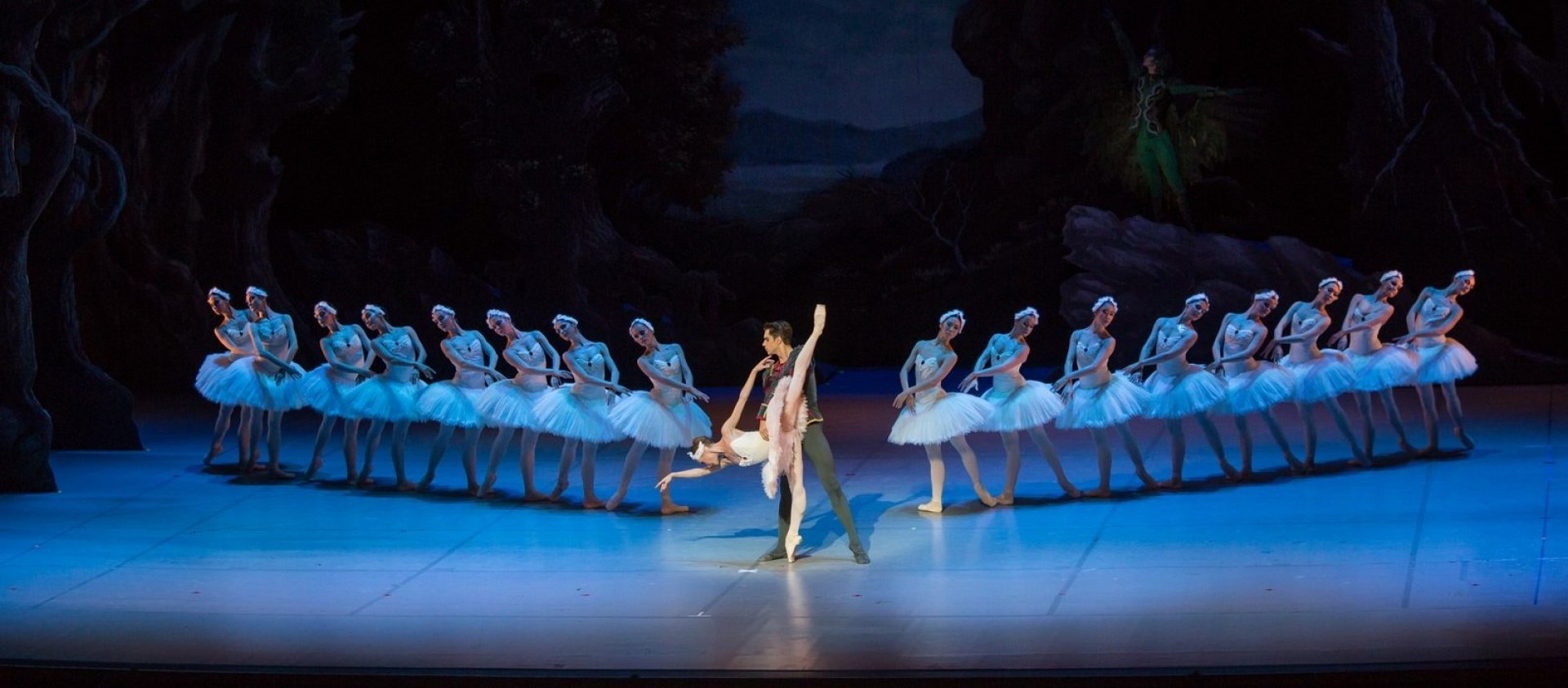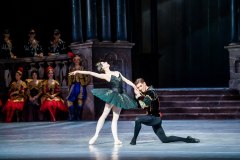Swan Lake
Mo | Tu | We | Th | Fr | Sa | Su |
SWAN LAKE | Rudi van Dantzig – Toer van Schayk / Pyotr Ilyich Tchaikovsky
Classical ballet in three acts
Performance length: 3 hours 45 minutes, with 2 intermissions.
Tchaikovsky’s first ballet is the most beloved classical piece in ballet literature: while the hardships of love between a prince forced into marriage and a maiden enchanted into the form of a swan is one of the most charming Russian romantic fairy tales, the piece nevertheless failed at its original premiere in 1877. The choreographers creating the premiere were simply not equal to Tchaikovsky’s genius. It was Marius Petipa's and Lev Ivanov's choreography that brought fame for the piece and established a tradition, and most companies to this day still dance the piece following this blueprint. Rudi van Dantzig and Toer van Schayk revised this classic creative work in 1988.
The same female ballet dancer portrays both Odette – the pure, innocent white swan– and Odile – the seductive, manipulative black swan in the Hungarian National Ballet’s production.
Synopsis
Act I
Siegfried’s birthday party in the castle garden To celebrate Siegfried’s eighteenth birthday, Alexander and the courtiers and neighbours have organized a surprise party for him in the garden of the castle. The Prince’s tutor Von Rasposen is irritated by Siegfried and Alexander’s friendly relationship with the local peasants. The festivities are interrupted by the arrival of the Queen, the Prince’s mother. She presents her son with a ring reminding him of his future role as successor to the throne: he will soon have to choose a bride. Siegfried is downcast at the prospect of his youth drawing to a close. As darkness falls he and Alexander ponder on the future. They decide to explore the surrounding forest.
Act II
The meeting with Odette Lost in the forest, Siegfried and Alexander arrive at the banks of a great lake. A huge circling bird of prey fills them with fear: it is as if the form of Von Rasposen is still spying on them. The bird of prey – in fact the wicked magician Von Rothbart – summons a swan out of the dark lake, which takes on human form. In Odette, the Swan Queen, and her retinue of swan maidens, Siegfried believes he has found the realization of his ideal of sincerity and simplicity. Surrounded by these pure shapes he is overcome with joy. He swears to remain forever true to his ideals.
Act III
The betrayal During a ball at the castle several brides-in-waiting are presented to Siegfried. But to the amazement of the guests, and to his mother’s alarm, Siegfried refuses to make a choice; all the pomp and splendour contrast starkly with the purity of the vision experienced at the lakeside. Von Rasposen announces the last guests: Von Rothbart, his daughter Odile and their retinue. Siegfried imagines that the Black Swan, Odile, is a manifestation of the White Swan Queen, Odette, but still he wavers. Von Rothbart and Odile blind him with a sensual display of dazzling virtuosity. To Alexander’s dismay Siegfried yields and offers Odile the ring. Too late he realizes that he has betrayed his ideal, Odette. Stricken, he flees back to the lake in despair.
Act IV
The reconciliation with Odette Disillusioned and betrayed, Odette and the swan maidens tarry by the moonlit lakeside, where Siegfried finds them. Odette forgives Siegfried and attempts to comfort him, telling him that he must learn to live with reality. Von Rothbart tries to drive Siegfried away from the lake, but although Siegfried manages to defy him, he drowns in the waters. Von Rasposen abandons his futile search for the Prince, while Alexander discovers the lifeless body of his friend. In Alexander, Siegfried’s ideals will live on.
Program and cast
Conductor: Gábor Hontvári, Máté Hámori
Odette /Odile: Tatyjana Melnyik, Maria Yakovleva, Soobin Lee, Maria Beck, Ellina Pohodnih
Siegfried: Dmitry Timofeev, Louis Scrivener, Boris Zhurilov, Gergő Ármin Balázsi
Rothbart: Takaaki Okajima, Mikalai Radziush, Vlagyiszlav Melnyik, Iurii Kekalo
Alexander: Alberto Ortega de Pablos, Viachaslau Hnedchyk, Valerio Palumbo, Taran Dumitru
Pas de trois girls: Yuki Wakabayashi, Miyu Takamori, Yuliya Radziush, Diana Kosyreva, Erina Yoshie, Nutsa Chekurashvili, Lili Felméry, Claudia García Carriera
Big Swans: Anastasiia Konstantinova, Stefanida Ovcharenko, Nika Kristina Crnić, Olha Skrypchenko, Lea Földi, Kristina Starostina, Nika Kristina Crnić, Adrienn Horányi
Little Swans: Kateryna Horiaieva, Rita Hangya, Yuliya Radziush, Matilde Noemi Barbaglia, Miyu Takamori, Jingxuan Li, Yuki Wakabayashi, Erina Yoshie, Diana Kosyreva, Elena Sharipova, Lili Felméry, Lilia Kaliko
Brides: Yuiko Adachi, Nika Kristina Crnić, Olha Skrypchenko, Anastasiia Konstantinova, Kristina Starostina, Stefanida Ovcharenko, Théa Solomon, Nutsa Chekurashvili, Olha Skrypchenko, Natsuna Oya, Ashlee Crowe, Lisa Roselli, Ágnes Kelemen, Adema Omarova, Remedios Agustín Castaño, Dóra Szelényi, Adrienn Horányi
Spanish girls: Lea Földi, Ágnes Kelemen, Dóra Szelényi, Yuiko Adachi, Adema Omarova, Remedios Agustín Castaño, Katerina Tarasova, Rachel Quintao, Anna Krupp
Spanish boys: Raffaello Barbieri, Vlagyiszlav Melnyik, Kóbor Demeter, Luca Massara, Takaaki Okajima, Léo Lecarpentier
Pas de six solos: Claudia García Carriera, András Rónai, Miyu Takamori, Motomi Kiyota, Elena Sharipova, Vince Topolánszky
Pas de six girls: Nutsa Chekurashvili, Yuliya Radziush, Yuki Wakabayashi, Jingxuan Li, Matilde Noemi Barbaglia, Erina Yoshie
Pas de six boys: Gaetano Cottonaro, Valerio Palumbo, Yago Guerra, Mattheus Bäckström, Alberto Ortega de Pablos, Carlos Taravillo Mahillo
Neapolitan girls: Rita Hangya, Ashlee Crowe, Natsuna Oya, Jessica Carulla Leon, Kateryna Horiaieva, Diana Kosyreva, Jingxuan Li, Lilia Kaliko, Stefanida Ovcharenko
Neapolitan boys: Motomi Kiyota, Yago Guerra, Riku Yamamoto, Francesco Sardella, Kristóf Morvai, Vince Topolánszky, Dmitry Zhukov, András Szegő, Dávid Molnár
Hungarian solos: Jessica Carulla Leon, Maxim Kovtun, Katerina Tarasova, Timofiy Bykovets, Anastasiia Konstantinova, Miklós Dávid Kerényi
Featuring the students of the Hungarian National Ballet Institute
Choreography after Marius Petipa and Lev Ivanov: Rudi van Dantzig
Choreography of folk dances: Toer van Schayk
Composer: Pyotr Ilyich Tchaikovsky
Set designer: Toer van Schayk
Costume designer: Toer van Schayk
Assistant set and costume designer: Ruud Lutgens
Lighting designer: Jan Hofstra
Répétiteur: Eleonora Demichelis, Toer van Schayk, Caroline Iura
Company répétiteur: Mária Aradi, Cristina Balaban, Tamás Solymosi, György Szirb, Marianna Venekei
Répétiteurs of the Hungarian National Ballet Institute: Dénes Kovács, Dace Radina
Hungarian State Opera
STANDING ROOM TICKETS - INFORMATION IN CASE OF A FULL HOUSE!
If all the seats are sold out for the selected time, but you still want to see the production on that day, 84 of the extremely affordable standing seats will be sold at the theatre, 2 hours before the start of the performance, with which you can visit the gallery on the 3rd floor. Tickets can be purchased at the ticket office of the Budapest Opera House. We would like to draw your attention to the fact that the stage can only be seen to a limited extent from the standing places and the side seats, but at the same time, following the performance is also supported by television broadcasting on the spot.
The Opera House is not only one of the most significant art relic of Budapest, but the symbol of the Hungarian operatic tradition of more than three hundred years as well. The long-awaited moment in Hungarian opera life arrived on September 27, 1884, when, in the presence of Franz Joseph I. the Opera House was opened amid great pomp and ceremony. The event, however, erupted into a small scandal - the curious crowd broke into the entrance hall and overran the security guards in order to catch a glimpse of the splendid Palace on Sugar út. Designed by Mikós Ybl, a major figure of 19th century Hungarian architecture, the construction lived up to the highest expectations. Ornamentation included paintings and sculptures by leading figures of Hungarian art of the time: Károly Lotz, Bertalan Székely, Mór Than and Alajos Stróbl. The great bronze chandelier from Mainz and the stage machinery moda by the Asphaleia company of Vienna were both considered as cutting-edge technology at that time.
Many important artists were guests here including Gustav Mahler, the composer who was director in Budapest from 1887 to 1891. He founded the international prestige of the institution, performing Wagner operas as well as Magcagni’ Cavalleria Rusticana. The Hungarian State Opera has always maintained high professional standards, inviting international stars like Renée Fleming, Cecilia Bartoli, Monserrat Caballé, Placido Domingo, Luciano Pavarotti, José Cura, Thomas Hampson and Juan Diego Flórez to perform on its stage. The Hungarian cast include outstanding and renowed artists like Éva Marton, Ilona Tokody, Andrea Rost, Dénes Gulyás, Attila Fekete and Gábor Bretz.

 EN
EN DE
DE IT
IT FR
FR ES
ES RU
RU JP
JP RO
RO
 Seating plan
Seating plan 




